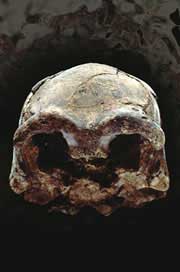Skull thwarts species-splitters

One-million-year-old skull found recently in Ethiopia. <br>© Nature/ Bill Atlanta <br>
Ethiopian fossil suggests early humans were one big family.
A one-million-year-old skull unearthed in Ethiopia hints that our long-extinct cousins Homo erectus were a varied and widespread bunch, much like today’s humans. The find may undermine previous claims that H. erectus was in fact made up of two different species.
Homo erectus, which means ’upright man’, appeared about 1.8 million years ago. Because of its posture and large brain, it is regarded as the first fully human group. H. erectus left Africa and spread throughout Eurasia from eastern China, possibly reaching as far as southern England.
Bony-browed and thick-jawed, H. erectus wielded primitive stone tools and may have been the first creature to make and use fire.
Since the 1980s, however, some scientists have suggested that 1.7-million-year-old H. erectus fossils from Africa and central Asia are so different to later 700,000-year-old examples that they belong to a different species, Homo ergaster.
The latest find could turn that theory on its head.
Face value
The fossil is in remarkably good shape considering it is a million years old, says Berhane Asfaw of the University of Addis Ababa in Ethiopia, one of the team that found the skull near the village of Bouri, 230 km northeast of Addis Ababa, in 1997. “It’s a complete skull cap with all the important features present,” Asfaw says.
The shape of the skull aligns it firmly with the recent H. erectus, but it shares some characteristics with older ones, says Asfaw. Its age also puts it right between where H. erectus and H. ergaster might have split. “Our fossil clearly links Asian and African forms of H. erectus,” says Asfaw1.
Unless something else turns up, the find strongly suggests that H. ergaster is a misnomer, Asfaw believes.
Alan Walker, who studies human evolution at Pennsylvania State University in University Park, agrees. “It is arbitrary to break up the lineage into and early ergaster and later erectus,” he says.
But Bernard Wood of George Washington University in Washington, DC, who first proposed the H. ergaster as a distinct group, is holding on to his idea. “It’s a terrific find,” he says and certainly relevant to H. erectus’ history. But he suspects the new find bears too little resemblance to H. ergaster to rule them out as a separate group.
Even if the skull does unify H. erectus as a group, it doesn’t simplify the picture of their history.
Finding a fossil in Ethiopia that looks like east Asian H. erectus suggests that anatomical features, such as skull shape, might have varied independently of location. Previously, the geographical separation of different forms of H. erectus fossils was thought to explain why they look the way they do.
References
- Asfaw, B. et al. Pleistocene hominids from Bouri Ethiopia integrate Homo erectus. Nature, 416, 317 – 320, (2002).
Media Contact
All latest news from the category: Interdisciplinary Research
News and developments from the field of interdisciplinary research.
Among other topics, you can find stimulating reports and articles related to microsystems, emotions research, futures research and stratospheric research.
Newest articles

Why getting in touch with our ‘gerbil brain’ could help machines listen better
Macquarie University researchers have debunked a 75-year-old theory about how humans determine where sounds are coming from, and it could unlock the secret to creating a next generation of more…

Attosecond core-level spectroscopy reveals real-time molecular dynamics
Chemical reactions are complex mechanisms. Many different dynamical processes are involved, affecting both the electrons and the nucleus of the present atoms. Very often the strongly coupled electron and nuclear…

Free-forming organelles help plants adapt to climate change
Scientists uncover how plants “see” shades of light, temperature. Plants’ ability to sense light and temperature, and their ability to adapt to climate change, hinges on free-forming structures in their…





















